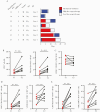Dysregulated Host Response in Severe Acute Respiratory Syndrome Coronavirus 2-Induced Critical Illness
- PMID: 33778090
- PMCID: PMC7928547
- DOI: 10.1093/ofid/ofab019
Dysregulated Host Response in Severe Acute Respiratory Syndrome Coronavirus 2-Induced Critical Illness
Abstract
Background: Impaired immune response has been reported to be the cause of the development of coronavirus disease 2019 (COVID-19)-related respiratory failure. Further studies are needed to understand the immunopathogenesis and to enable an improved stratification of patients who are at risk for critical illness.
Methods: Thirty-two severely ill patients hospitalized with COVID-19 were recruited in our center at the University Hospital Heidelberg. We performed a comprehensive analysis of immune phenotype, cytokine, and chemokine profiling and leukocyte transcripts in patients with severe COVID-19 and compared critically ill patients who required mechanical ventilation and high-flow oxygen therapy and noncritically ill patient who received low-flow oxygen therapy.
Results: Critically ill patients exhibited low levels of CD8 T cells and myeloid dendritic cells. We noted a pronounced CCR6+ TH17 phenotype in CD4 central memory cells and elevated circulating levels of interleukin-17 in the critical group. Gene expression of leukocytes derived from critically ill patients was characterized by an upregulation of proinflammatory cytokines and reduction of interferon (IFN)-responsive genes upon stimulation with Toll-like receptor 7/8 agonist. When correlating clinical improvement and immune kinetics, we found that CD8 T-cell subsets and myeloid dendritic cells significantly increased after disconnection from the ventilator.
Conclusion: Critical illness was characterized by a TH17-mediated response and dysfunctional IFN-associated response, indicating an impaired capacity to mount antiviral responses during severe acute respiratory syndrome coronavirus 2 severe infection.
Keywords: COVID-19; IFN-responsive genes; TH17 immunity; critical illness; inflammation.
© The Author(s) 2021. Published by Oxford University Press on behalf of Infectious Diseases Society of America.
Figures




References
-
- World Health Organization. Clinical management of COVID-19: interim guidance. 2020. Available at: https://www.who.int/publications/i/item/clinical-management-of-covid-19.
Grants and funding
LinkOut - more resources
Full Text Sources
Other Literature Sources
Research Materials

